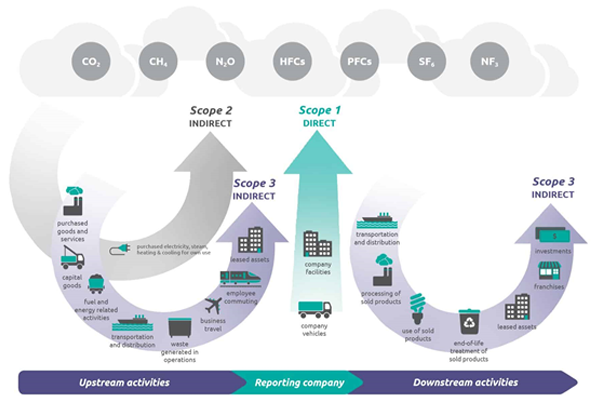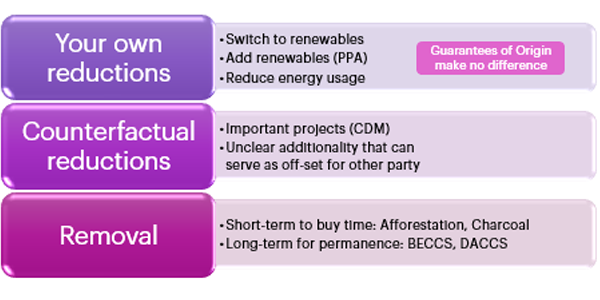
In the efforts to limit global warming to 1.5 °C, there is broad consensus that multiple mitigation tools will be necessary. Most of these efforts have so far been focused on reducing the use of fossil fuels in different ways, notably by replacing them with renewable energy.
Reducing and replacing fossil fuels with renewable energy is and will remain the main mitigation tool. CDR is a different, complementary, tool. CDR goes further than reducing usage of fossil fuels or efforts to maintain fossil emission levels. CDR, instead, removes CO2 such that the concentration of CO2 in the atmosphere is reduced in absolute numbers, directly contributing to reversing global warming.
There are different ways to perform CDR and different ways to take care of the removed CO2. Fundamental to all these methods is the need to capture and remove CO2 that is not directly associated with production of fossil fuels or industrial production emitting carbon dioxide. Capture of CO2 directly connected to such production is not a net removal, but a way to maintain current emission levels, corresponding to CCS – Carbon Capture and Storage.
The most frequently used methods for CDR is, one the one hand, the nature-based methods where carbon can be captured by afforestation and, on the other, the technology-based methods such as Bio Energy Carbon Capture and Storage (BECCS) and Direct Air Capture and Storage (DACCS). There is also CCU. That implies that the captured CO2 is used in some product application, for instance synthetic fuel. When “usage” is applied, there can be a temporary removal, but never a long-term net removal.

For BECCS, the carbon removal is based on capturing biogenic CO2. In the natural biogenic CO2 cycle trees consume and store CO2 as part of the photosynthesis. When forest residues are used as bioenergy, for instance for heating, the biogenic CO2 in the residues is released back the atmosphere again, thereby creating a net-zero CO2 cycle. With BECCS, the biogenic CO2 that is released during heat production is captured, and thus not released back to the atmosphere. Since this CO2 is stored, the net effect is that there has been a reduction of CO2 in the atmosphere.
In the view of Stockholm Exergi, BECCS is the best form of CDR, since it has the potential to remove significant volumes of CO2 permanently, as the carbon dioxide is geologically stored for several thousands of years. Already in 2005 did IPCC conclude that geologically stored CO2 had a probability of 99% or more to remain in storage after 1 000 years.
When all reasonable efforts to reduce fossil emissions have been made, there will still be Green House Gases (GHG) emitted to the atmosphere. This statement can be interpreted differently depending on which time horizon you apply.
In the IPCC report SR15 from 2018, it is made clear that CDR in different forms will be necessary to limit global warming to 1.5 °C with no or limited overshoot (overshoot implies that the temperature increase will initially be larger but then go back to 1.5 °C). In the IPCC modelling, many different scenarios are analyzed representing different levels of success regarding the reduction of fossil fuels and the deployment of CDR. Practically all scenarios foresee the use of BECCS, which is also expected to be responsible for the majority of CDR.

In the 2050 perspective, we need to achieve net-zero emissions. If the transformation to a carbon free economy has been successful and fast, the application of CDR/BECCS will at that point in time only be required for diffuse and difficult-to-eliminate emissions, be it CO2 or other GHGs, notably in the agricultural sector. If the transformation has been slow and/or less successful, the need for CDR/BECCS will be significantly higher and, in principle, cover emissions from all sectors of the economy. At any rate, there is a need to start building a BECCS infrastructure already now to be prepared to manage a wide range of scenario outcomes.
In the short to medium perspective, a corporation targeting to be a leader in the transformation towards a carbon-free economy will look to address its GHG Scope 1-3 emissions with reducing as far as possible its own direct emissions and to compensate for other indirect measures in its value chain.

There is a wide range of measures a company can take to compensate for the indirect emissions (Scope 1 and 2). In selecting those measures, many companies are already concluding that CDR, and in particular BECCS, is the most reliable and valuable measure since it is easy to understand and validate the actual impact of the measure, namely that CO2 is withdrawn from the atmosphere for good.
Other types of measures to compensate for a company’s indirect emissions often rely on counterfactual scenarios that CO2 emissions would have been higher, had not the company contributed to another party’s renewable project by purchasing some kind of certificate corresponding to an emission reduction. Such projects can be an important part of the decarbonization. However, it is very difficult to establish the real impact on the climate of the contribution by the company and the project does not physically neutralize the emissions of the company. Thus, it is unclear to what extent such compensatory measures have a positive additional impact on emission reductions such that it is legitimate to use it to off-set the company’s indirect emissions.

For a company relying on CDR/BECCS, no such uncertainty exist. Also, the companies acquiring “carbon removal certificates” in the short to medium term also help build the necessary CDR infrastructure that will be required by 2050, as outlined above.
Bio-enegy Carbon Capture and Storage is a new and exciting concept just about to take the step from exploration to industrial deployment. The technology is, by IPCC, predicted to be essential to limit global warming to 1.5 °C. On this page we share news and our ideas how BECCS will contribute to a cooler world.